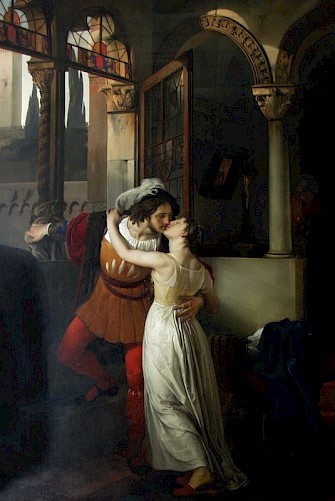Villa Carlotta
Via Regina, 2 - 22016 Tremezzina
Tremezzo, Como
Ph. (+39) 0344 40405
Fax (+39) 0344 43689
Öffnungszeiten
Opening 2024: 22nd March
Jetzt zu sehen
The beauty of the camellias announces the spring!
Via Regina, 2 - 22016 Tremezzina
Tremezzo, Como
Ph. (+39) 0344 40405
Fax (+39) 0344 43689
Opening 2024: 22nd March
The beauty of the camellias announces the spring!
The painting, inspired by Shakespeare’s well-loved tragedy, was commissioned by one of the most famous collectors of the time, Giovanni Battista Sommariva. It was exhibited in Brera, in 1823, together with another large canvas purchased by the German count, Schönborn-Wiesentheid, whose subject matter was from an older source, however, a novella by Da Porto: The Marriage of Romeo and Juliet (Pommersfelden, Graf von Schönborn Kunstsammlungen).

Francesco Hayez
L’ultimo bacio dato a Giulietta da Romeo, 1823
olio su tela, 291×201,8 cm
Hayez returned to this theme in three other paintings: in 1825 and twice in 1830, culminating with the evolution of the subject into the popular Kiss series, beginning in 1859.
There are different, striking elements, such as the accurate, evocative reconstruction of the setting, sensuality reminiscent of Titian, the sumptuous rendering of costumes, like the “the damsel’s robe, whose lustre imitates the most beautiful French velvet.” The foremost Romantic critic, Defendente Sacchi, deemed it a sort of manifesto, given that “his Juliet is certainly not Venus and neither is she a woman of ancient times she is lovely, but lovely because she loves”, while “Romeo is not Antinous, nor Apollo, yet he arouses the curiosity of women and is clearly the cream of the brave and of lovers.” But it was Ludwig Schorn – authoritative correspondent of the German Kunst-Blatt in Milan – who opened the debate, disapproving the excessive realism of that “kiss”, which “is voluptuous”, “not the tender love of a pure enchanted soul”.
William Shakespeare, Romeo and Juliet, Act III, scene V
In 2015, the University of Insubria’s Department of Science and High Technology conducted a complex analysis to identify the techniques and pigments – including white lead, ivory black, Prussian blue – used by Hayez in the painting. Reflectography and false colour imaging studies were performed. The research revealed that the artist had second thoughts for the geometry of the architectural motifs and some obvious regret with regard to Romeo’s left foot.
Download a pdf with the results of the analysis (in Italian)
In 2015, the University of Insubria’s Department of Science and High Technology conducted a complex analysis to identify the techniques and pigments – including white lead, ivory black, Prussian blue – used by Hayez in the painting. Reflectography and false colour imaging studies were performed. The research revealed that the artist had second thoughts for the geometry of the architectural motifs and some obvious regret with regard to Romeo’s left foot.
Download a pdf with the results of the analysis (in Italian)
Home / Das Museum / Chamber of Hayez / The Kiss

